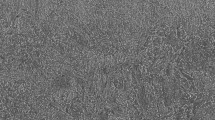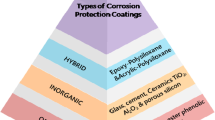Abstract
In this work, the corrosion inhibition performance of 1,2,3 – Benzotriazole (BTA) as an organic inhibitor for cold rolled mild steel in an acidic medium was investigated. For this, different loading ratios of BTA were utilized and their efficiency as corrosive inhibitor either within the coating film or within the electrolyte was discussed. The first set of the samples was fabricated by the incorporation of 0.1 wt.%, 0.5 wt.%, and 1.0 wt.% BTA within the acrylic polymer host matrix. The influence of BTA to the structural, optical, and adhesion properties of the acrylic coating films was examined. The obtained results revealed no significant changes resulted from the addition of different concentrations of BTA. The other set of the samples was developed by dissolving different concentration of BTA specifically, 100 ppm, 500 ppm, and 1000 ppm within the acidic electrolyte. All tested substrates were coated with acrylic based coating systems in the presence of polyisocyanate (NCO) as a curing agent. 0.5 M H2SO4 was used as the corrosive electrolyte and the corrosion protection performance of the two sets of the samples was investigated via electrochemical impedance spectroscopy (EIS). The obtained results confirmed the way of introduction influenced the performance of the BTA as a corrosion inhibitor. The best corrosion protection and the intact behavior was observed by adding 0.1 wt.% of BTA within the acrylic coating film even after 30 days of exposure of coated substrate to H2SO4 solution.







Similar content being viewed by others
References
Dehri I, Erbil M (2000) The effect of relative humidity on the atmospheric corrosion of defective organic coating materials: an EIS study with a new approach. Corros Sci 42:969–978. https://doi.org/10.1016/S0010-938X(99)00126-2
Asri RIM, Harun WSW, Samykano M, Lah NAC, Ghani SAC, Tarlochan F, Raza MR (2017) Corrosion and surface modification on biocompatible metals: a review. Mater Sci Eng C 77:1261–1274. https://doi.org/10.1016/j.msec.2017.04.102
Vimalanandan A, Lv LP, Tran TH, Landfester K, Crespy D, Rohwerder M (2013) Redox-responsive self-healing for corrosion protection. Adv Mater 25:6980–6984. https://doi.org/10.1002/adma.201302989
Galliano F, Landolt D (2002) Evaluation of corrosion protection properties of additives for waterborne epoxy coatings on steel. Prog Org Coatings 44:217–225. https://doi.org/10.1016/S0300-9440(02)00016-4
Brady RF (2001) A fracture mechanical analysis of fouling release from nontoxic antifouling coatings. Prog Org Coatings 43:188–192. https://doi.org/10.1016/S0300-9440(01)00180-1
Stratmann M, Feser R, Leng A (1994) Corrosion protection by organic films. Electrochim Acta 39:1207–1214. https://doi.org/10.1016/0013-4686(94)E0038-2
Presuel-Moreno F, Jakab MA, Tailleart N, Goldman M, Scully JR (2008) Corrosion-resistant metallic coatings. Mater Today 11:14–23. https://doi.org/10.1016/S1369-7021(08)70203-7
Xue D, Yun Y, Schulz MJ, Shanov V (2011) Corrosion protection of biodegradable magnesium implants using anodization. Mater Sci Eng C 31:215–223. https://doi.org/10.1016/j.msec.2010.08.019
Odarczenko M, Thakare D, Li W, Yang K, Tang S, Venkateswaran SP, Sottos NR, White SR (2018) Self-protecting epoxy coatings with anticorrosion microcapsules. ACS Omega 3:14157–14164. https://doi.org/10.1021/acsomega.8b01950
Wonnie Ma IA, Sh A, K R et al (2017) Anticorrosion properties of epoxy-nanochitosan nanocomposite coating. Prog Org Coatings 113:74–81. https://doi.org/10.1016/j.porgcoat.2017.08.014
Li M, Qiang X, Xu W, Zhang H (2015) Synthesis, characterization and application of AFC-based waterborne polyurethane. Prog Org Coatings 84:35–41. https://doi.org/10.1016/j.porgcoat.2015.02.009
Jones FN, Nichols ME, Pappas SP (Socrates P (2017) Organic coatings : science and technology, 4th ed. John Wiley & Sons, Hoboken
Mohamad Saidi N, Shafaamri AS, Wonnie Ma IA, Kasi R, Balakrishnan V, Subramaniam R (2018) Development of anti-corrosion coatings using the disposable waste material. Pigment Resin Technol 47:478–484. https://doi.org/10.1108/PRT-03-2018-0030
Wonnie Ma IA, Shafaamri A, Kasi R et al (2017) Anticorrosion Properties of Epoxy / Nanocellulose Nanocomposite Coating. Bioresources 12:2912–2929. https://doi.org/10.15376/biores.12.2.2912-2929
Atrens A, Liu M, Zainal Abidin NI (2011) Corrosion mechanism applicable to biodegradable magnesium implants. Mater Sci Eng B Solid-State Mater Adv Technol 176:1609–1636. https://doi.org/10.1016/j.mseb.2010.12.017
Shreepathi S, Bajaj P, Mallik BP (2010) Electrochemical impedance spectroscopy investigations of epoxy zinc rich coatings: role of Zn content on corrosion protection mechanism. Electrochim Acta 55:5129–5134. https://doi.org/10.1016/j.electacta.2010.04.018
Ramezanzadeh B, Niroumandrad S, Ahmadi A, Mahdavian M, Moghadam MHM (2016) Enhancement of barrier and corrosion protection performance of an epoxy coating through wet transfer of amino functionalized graphene oxide. Corros Sci 103:283–304. https://doi.org/10.1016/j.corsci.2015.11.033
Jerome EU (2015) Corrosion inhibition of mild steel in 1m HCL using unripe plantain Peel extracts. Int J Sci Technoledge 3:6–12
Saji VS (2010) A review on recent patents in corrosion inhibitors. Recent Patents Corros Sci 2:6–12. https://doi.org/10.2174/1877610801002010006
Döner A, Solmaz R, Özcan M, Kardaş G (2011) Experimental and theoretical studies of thiazoles as corrosion inhibitors for mild steel in sulphuric acid solution. Corros Sci 53:2902–2913. https://doi.org/10.1016/j.corsci.2011.05.027
Wang X, Yang H, Wang F (2011) An investigation of benzimidazole derivative as corrosion inhibitor for mild steel in different concentration HCl solutions. Corros Sci 53:113–121. https://doi.org/10.1016/j.corsci.2010.09.029
Komatsu D, Souza EC, De Souza EC et al (2010) Effect of antioxidants and corrosion inhibitor additives onthe quenching performance of soybean oil. Stroj Vestnik/Journal Mech Eng 56:121–130
Rahimi A, Amiri S (2015) Anticorrosion hybrid nanocomposite coatings with encapsulated organic corrosion inhibitors. J Coatings Technol Res 12:587–593. https://doi.org/10.1007/s11998-015-9657-4
Gunasekaran G, Chauhan LR (2004) Eco friendly inhibitor for corrosion inhibition of mild steel in phosphoric acid medium. Electrochim Acta 49:4387–4395. https://doi.org/10.1016/j.electacta.2004.04.030
Barchiche C, Sabot R, Jeannin M, Refait P (2010) Corrosion of carbon steel in sodium methanoate solutions. Electrochim Acta 55:1940–1947. https://doi.org/10.1016/j.electacta.2009.11.013
Bellakhal N, Dachraoui M (2004) Study of the benzotriazole efficiency as a corrosion inhibitor for copper in humid air plasma. Mater Chem Phys 85:366–369. https://doi.org/10.1016/j.matchemphys.2004.01.011
Mersagh Dezfuli S, Sabzi M (2018) A study on the effect of presence of CeO2and benzotriazole on activation of self-healing mechanism in ZrO2ceramic-based coating. Int J Appl Ceram Technol 15:1248–1260. https://doi.org/10.1111/ijac.12901
Ling Y, Guan Y, Han KN (1995) Corrosion inhibition of copper with benzotriazole and other organic surfactants. Corrosion 51:367–375. https://doi.org/10.5006/1.3293601
Srikanth AP, Sunitha TG, Raman V, Nanjundan S, Rajendran N (2007) Synthesis , characterization and corrosion protection properties of coatings on mild steel. Appl Surf Sci 103:241–247. https://doi.org/10.1016/j.matchemphys.2007.02.021
Yasakau KA, Zheludkevich ML, Karavai OV, Ferreira MGS (2008) Influence of inhibitor addition on the corrosion protection performance of sol-gel coatings on AA2024. Prog Org Coatings 63:352–361. https://doi.org/10.1016/j.porgcoat.2007.12.002
Liu C, Ren X (2018) Synthesis and characterization of controlled benzotriazole light stabilizer by RAFT polymerization and its application. J Polym Res 25:97. https://doi.org/10.1007/s10965-018-1491-9
Lei YH, Sheng N, Hyono A, Ueda M, Ohtsuka T (2014) Effect of benzotriazole (BTA) addition on Polypyrrole film formation on copper and its corrosion protection. Prog Org Coatings 77:339–346. https://doi.org/10.1016/j.porgcoat.2013.10.009
Ammar S, Ramesh K, Vengadaesvaran B, Ramesh S, Arof AK (2016) Formulation and characterization of hybrid polymeric/ZnO nanocomposite coatings with remarkable anti-corrosion and hydrophobic characteristics. J Coatings Technol Res 13:921–930. https://doi.org/10.1007/s11998-016-9799-z
Vengadaesvaran B (2013) Evaluation of heat resistant properties of silicone-acrylic polyol coating by electrochemical methods. Pigment Resin Technol 42:117–122. https://doi.org/10.1108/03699421311301106
Ammar S, Ramesh K, Vengadaesvaran B, Ramesh S, Arof AK (2016) A novel coating material that uses nano-sized SiO2 particles to intensify hydrophobicity and corrosion protection properties. Electrochim Acta 220:417–426. https://doi.org/10.1016/j.electacta.2016.10.099
Ravichandran R, Nanjundan S, Rajendran N (2004) Effect of benzotriazole derivatives on the corrosion of brass in NaCl solutions. Appl Surf Sci 236:241–250. https://doi.org/10.1016/j.apsusc.2004.04.025
Qu Q, Jiang S, Bai W, Li L (2007) Effect of ethylenediamine tetraacetic acid disodium on the corrosion of cold rolled steel in the presence of benzotriazole in hydrochloric acid. Electrochim Acta 52:6811–6820. https://doi.org/10.1016/j.electacta.2007.04.114
Chen Z, Huang L, Zhang G, Qiu Y, Guo X (2012) Benzotriazole as a volatile corrosion inhibitor during the early stage of copper corrosion under adsorbed thin electrolyte layers. Corros Sci 65:214–222. https://doi.org/10.1016/j.corsci.2012.08.019
Pingan H, Mengjun J, Yanyan Z, Ling H (2017) A silica/PVA adhesive hybrid material with high transparency, thermostability and mechanical strength. RSC Adv 7:2450–2459. https://doi.org/10.1039/C6RA25579E
Liu F, Wang Y, Xue X, Yang H (2015) UV curable EA-Si hybrid coatings prepared by combination of radical and cationic photopolymerization. Prog Org Coatings 85:46–51. https://doi.org/10.1016/j.porgcoat.2015.03.002
Retegi A, Algar I, Martin L, Altuna F, Stefani P, Zuluaga R, Gañán P, Mondragon I (2012) Sustainable optically transparent composites based on epoxidized soy-bean oil (ESO) matrix and high contents of bacterial cellulose (BC). Cellulose 19:103–109. https://doi.org/10.1007/s10570-011-9598-8
Liu XY, Guo H, Ye S, Peng MY, Zhang QY (2015) Enhanced tunable color emission in transparent Ag/Mn2+ codoped zinc borate glasses for broad band light source. J Mater Chem C 3:5183–5191. https://doi.org/10.1039/c5tc00641d
Ammar S, Iling AWM, Ramesh K, Ramesh S (2020) Development of fully organic coating system modified with epoxidized soybean oil with superior corrosion protection performance. Prog Org Coatings 140:105523. https://doi.org/10.1016/j.porgcoat.2019.105523
Basiru YA, Ammar S, Ramesh K, Vengadaesvaran B, Ramesh S, Arof AK (2018) Corrosion protection performance of nanocomposite coatings under static, UV, and dynamic conditions. J Coatings Technol Res 15:1–13. https://doi.org/10.1007/s11998-017-0038-z
Amirazodi K, Sharif M, Bahrani M (2019) Polypyrrole doped graphene oxide reinforced epoxy nanocomposite with advanced properties for coatings of mild steel. J Polym Res 26(244):244. https://doi.org/10.1007/s10965-019-1905-3
Kamburova K, Boshkova N, Boshkov N, Radeva T (2016) Design of polymeric core-shell nanocontainers impregnated with benzotriazole for active corrosion protection of galvanized steel. Colloids Surfaces A Physicochem Eng Asp 499:24–30. https://doi.org/10.1016/j.colsurfa.2016.03.067
Ammar S, Ramesh K, Ma IAW, Farah Z, Vengadaesvaran B, Ramesh S, Arof AK (2017) Studies on SiO<inf>2</inf>−hybrid polymeric nanocomposite coatings with superior corrosion protection and hydrophobicity. Surf Coatings Technol 324:536–545. https://doi.org/10.1016/j.surfcoat.2017.06.014
Richards CAJ, McMurray HN, Williams G (2019) Smart-release inhibition of corrosion driven organic coating failure on zinc by cationic benzotriazole based pigments. Corros Sci 154:101–110. https://doi.org/10.1016/j.corsci.2019.04.005
Acknowledgments
The authors extend their appreciation to University of Malaya for providing research IIRG007C-19IISS, the Ministry of Higher Education for providing Fundamental Research Grant (FP036-2018A) and the Deanship of Scientific Research at King Khalid University through Large Research Group Project under grant number R.G.P. 2/60/40 for funding this study.
Author information
Authors and Affiliations
Corresponding author
Additional information
Publisher’s note
Springer Nature remains neutral with regard to jurisdictional claims in published maps and institutional affiliations.
Rights and permissions
About this article
Cite this article
Ammar, S., Ma, I.A.W., Muhammad, F.M.S. et al. Electrochemical studies of 1,2,3-Benzotriazole inhibitor for acrylic-based coating in different acidic media systems. J Polym Res 27, 142 (2020). https://doi.org/10.1007/s10965-020-02130-4
Received:
Accepted:
Published:
DOI: https://doi.org/10.1007/s10965-020-02130-4




